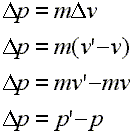- Messages
- 1,229
- Reaction score
- 740
- Points
- 123
If there is any region where the velocity is negative you would need to treat each of those sections as yet more pieces. In those pieces the DISTANCE is positive and is added on prior to calculating average speed.[/QUOTE]
Yes the answer is 0.15m
Btw If we have to find average velocity, the displacement will be -ve in those regions of the section where velocity is below zero, right?
Yes the answer is 0.15m
Btw If we have to find average velocity, the displacement will be -ve in those regions of the section where velocity is below zero, right?

